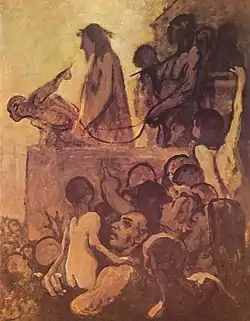| Ecce Homo | |
|---|---|
 | |
| Artist | Honoré Daumier |
| Year | 1850 |
| Medium | oil on canvas |
| Dimensions | 163 cm × 130 cm (64 in × 51 in) |
| Location | Museum Folkwang, Essen |
Ecce Homo is an unfinished oil-on-canvas painting by the French painter and caricaturist Honoré Daumier, created in 1850. It is in the collection of the Museum Folkwang in Essen, Germany.[1]
The painting, executed in undertones of various shades of brown, depicts a scene in the Good Friday trial of Jesus when Christ is presented to the mob as a figure of ridicule by Pontius Pilate with the words "Ecce Homo", translated in the Bible as "Behold the Man", but more appropriately as an accusatory "Look at this man". The viewer is situated in the crowd in a position where he can observe Christ standing still and resolute, silhouetted against a sacred light, and asked to decide whether to sympathise with Him or with His tormentors.
The work is one of only a few that Daumier undertook on religious subjects, as distinct from his several depictions of contemporary French social inequalities.
The painting was included by French writer Michel Butor in his book selecting 105 decisive works of Western painting.[2]
See also
References
- ↑ "Good Friday – Ecce Homo by Honoré Daumier". ArtWay. Retrieved 23 June 2020.
- ↑ Michel Butor, Le Musée imaginaire de Michel Butor: 105 œuvres décisives de la peinture occidentale, Paris, Flammarion, 2019, pp. 234–235 (French) ISBN 978-2-08-145075-2